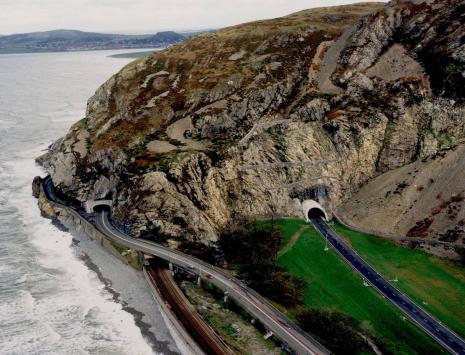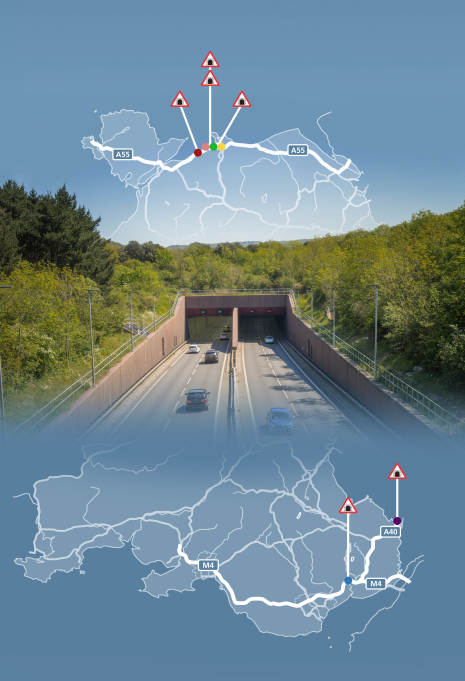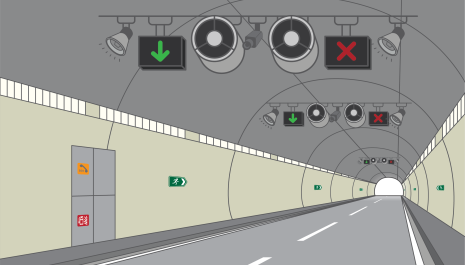Travelling through the tunnels will not normally present any danger. Tunnels provide additional challenges to the public and the emergency services in the event of an incident.
A number of safety features and procedures have been developed to help the public to safely evacuate the tunnel or allow emergency services access to manage incidents should they occur.
This page provides you with information about the tunnels and advice on how to avoid becoming involved in a tunnel incident and how to look after your own and others’ safety.
There are 6 Motorway and Trunk Road Tunnels in Wales.
A55 Conwy Tunnel
Built in 1991, this immersed tube tunnel was the first of its kind in the UK. At 1060m, the tunnel is the longest road tunnel in Wales.
A55 Penmaenbach Tunnel
Penmaenbach Tunnel opened in 1989 to carry westbound traffic. It is 658 metres in length and was blasted through the hillside.
A55 Penmaenbach Headland Tunnel
Built in 1932 Penmaenbach Headland tunnel was cut into the cliff by hand. It replaced the original coach road built by Telford in the early 19th century.
A55 Pen-y-Clip Tunnel
This tunnel was opened in 1994 after three-and-a-half years boring and shoring work that removed more than 103,000 cubic metres of granite from the headland.
M4 Brynglas Tunnel
The 360m twin bore, two lane holes, opened in 1967, are significant because they were the first tunnels to be built on the British motorway network.
A40 Gibraltar Tunnel
Built in 1969, these are a pair of bored tunnels, carrying the A40 through Gibraltar Hill.
|
TUNNEL LIGHTING Lighting to improve visibility inside the tunnel. |
VENTILATION SYSTEMS To clear pollution and control heat and smoke to assist evacuation during a fire incident. |
|
FIRE EXTINGUISHERS Emergency panels are equipped with fire extinguishers. |
WAYFINDERS Identify direction and distance to emergency exits for pedestrians from a tunnel. |
|
CCTV CCTV are there to help the Traffic Management Centres monitor tunnel operations and detect incidents. |
PUBLIC ADDRESS Speakers are located throughout the tunnel. In the event of an incident listen to any announcements and follow all instructions given. |
|
EMERGENCY PANELS (SOS) Emergency panels are marked by illuminated signs. They are equipped with fire extinguishers and free call SOS phones linked to the Traffic Management centre. |
EMERGENCY ACCESS DOORS Emergency access doors are installed in some tunnels to allow emergency services access to an emergency from the non-affected tunnel bore. Wherever possible evacuation should be via the tunnel portals. |
|
LANE CONTROL SIGNALS Indicates which lanes are open or closed. Observe and obey at all times. |
|
Observe all speed limits on the approaches to and through the Tunnel – caution these may change. |
|
|
Check you have sufficient fuel for your journey. |
|
|
Observe and obey signs and signals - Never use a lane displaying a red cross. |
|
|
Use dipped headlights. Remove your sunglasses if in use. |
|
|
If there is smoke or fire ahead of you in the tunnel, do not enter. Pull over into the left-hand lane, stop and switch on your hazard warning lights. |
|
Do not stop unless in case of an emergency. |
|
|
Keep a safe distance between you and the vehicle in front. Vehicles should leave at least a 2 second gap and large goods vehicle a 4 second gap. |
|
|
Do not turn or reverse unless instructed by a Police or Traffic Officer. |
|
|
Do not discard cigarettes within the confines of the tunnel. |
|
Keep your distance, even if you are moving slowly or have stopped - always leave a gap of at least 5 metres between you and the vehicle in front (an average car length). |
|
|
Switch off engine if stationary for more than one minute. |
|
|
Switch on Hazard warning lights when approaching congestion in accordance with the Highway Code. |
|
|
Listen to messages broadcast over the public address system and follow the instructions given by the tunnel operator at all times. |
|
Switch on Hazard warning lights. |
|
|
Stop your vehicle as close to the left-hand side as possible and switch off the engine. Leave the key in the ignition. |
|
|
Be aware of approaching traffic from front or rear. If possible exit your vehicle from the left hand door. Passengers should do likewise. If you are unable to exit the vehicle for any reason dial 999. The tunnels are closely monitored and assistance will be provided as soon as possible. |
|
|
Call for help from a telephone at the SOS emergency points located every 100 metres along the tunnel. Be aware of other vehicles. DO NOT cross the carriageway. |
|
|
Listen to messages over the public address system and follow the instructions given by the tunnel operator. |
|
|
Do not attempt any repairs whilst in the tunnel. |
|
If there is smoke or fire ahead of you in the tunnel, do not enter. Pull over into the left-hand lane, stop and switch on your hazard warning lights. |
|
|
If there is smoke or fire ahead of you in the tunnel, then pull over to the left-hand side and stop. Switch off the engine, leave the key in the ignition and evacuate the vehicle. Leave the tunnel on foot, following the signed evacuation route towards the tunnel portal through which you drove to enter the tunnel. Once outside the tunnel, wait at the signed evacuation point for further assistance. |
|
|
If you observe smoke or a fire behind you once in the tunnel, continue to drive out of the tunnel and do not re-enter. |
|
|
If your vehicle is on fire then drive out of the tunnel if possible. If this is not possible, then pull over to the left side and switch off the engine. Leave the key in the ignition in case the emergency services need to move your vehicle. Evacuate immediately. Leave the tunnel following the signed evacuation route towards the nearest tunnel portal. Once outside the tunnel wait at the signed evacuation point for assistance. |
|
|
Call for help at the SOS phones located at the evacuation point outside the tunnel. |
|
|
Listen to any messages over the public address system and follow the instructions given by the tunnel operator. |
|
|
There are fire extinguishers next to every emergency panel within the tunnels. |



